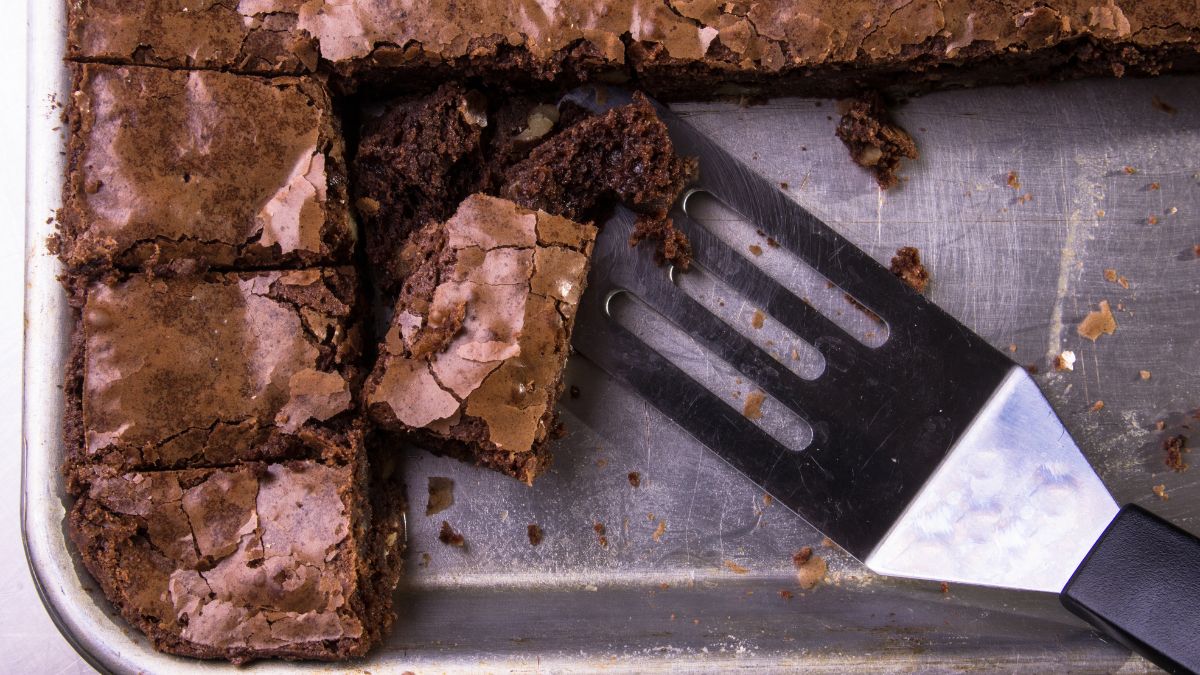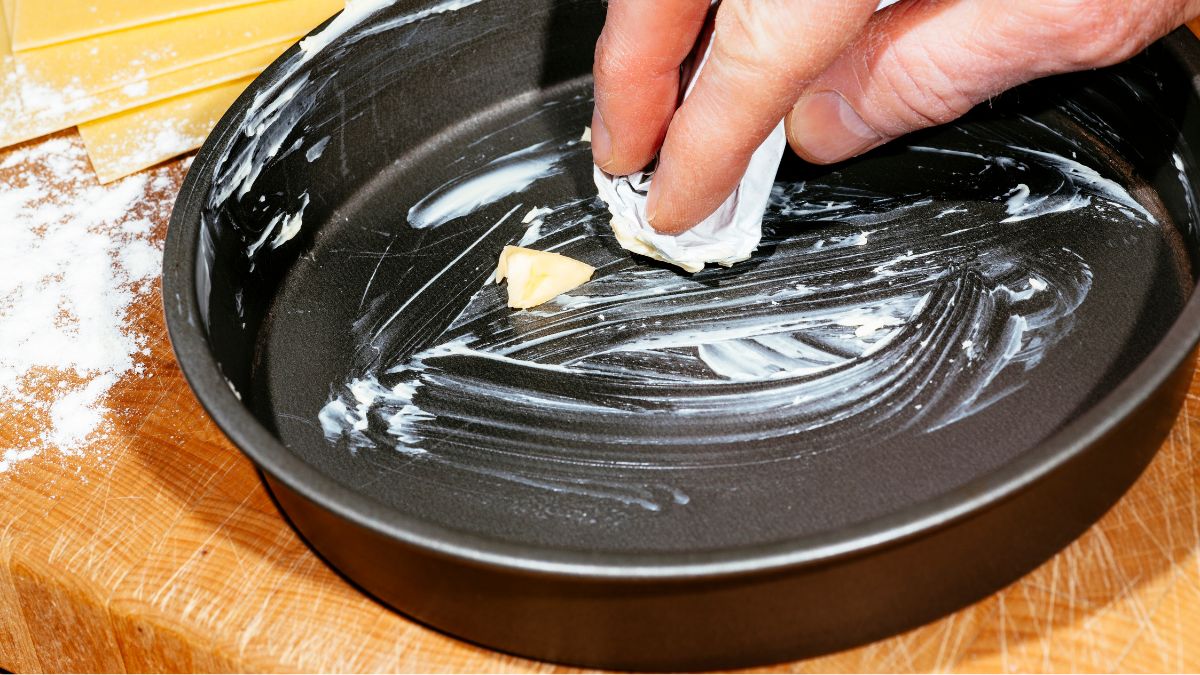How to Grease a Pan for Brownies & Take Them Out Whole?

Brownies are probably the easiest and tastiest cake to make. They pair with everything, from ice cream and fruit to exotic spices like chili and cardamom. I like them served in a load of sauce, whether vanilla, strawberry, or salted caramel when I feel fancy. They don’t need to be perfectly cut as their charm lies in the rustic look. But, still, you’ll want your choco-pieces of heaven served without a fuss or crumbling. Because of that, here comes a rescue in 3 ways on how to grease a pan for brownies!
There are 3 simple but effective methods: spraying, brushing, and massaging. The first one is the easiest, but the other two give more flavor, whatsoever. A pastry brush or paper towel will help you smear just enough oil of your choice, while the crumpled-up baking paper or your fingers are the best options when using solid fats.
I love to play with different flavors, so I’ll usually choose some of the unique aromatic herbs and spices-infused oils. But when I want a homey taste, butter is my go-to option. Keep reading for some tips and tricks on how to make sure the brownies won’t stick to the pan and how to take them out, what pans to choose, and everything you need to know for a perfect bite!
Nonstick Cooking Spray
A nonstick cooking spray is a handy option to take out a perfect brownie. Cooking spray is oil, but not oil only. It actually contains food additives, as well – emulsifiers, anti-foaming agents, and propellants.
What’s best is spraying scatters the oil evenly without skipping a beat. Just spray it a few inches away from the pan to secure that! You can undoubtedly expect to remove a perfectly edged-brownie from the baking pan.
One more plus thing is you can save calories by using it! I always choose this option when counting calories because you’ll get zero to a few calories per whole pan of brownies. It will prevent brownies from sticking with just one layer of aerosol!
Brush the Oil
Oil is a standard, reliable option! From neutral to aromatic oils and everything In between, it all works well, depending on what flavor you’re aiming for. The key to all of them is thorough application – with a brush or paper towel!
Don’t forget the sides all the way to the top, as lubricating them makes brownie leaven better. You don’t need to use much, probably a teaspoon or so, depending on the size of your dish – you’re aiming for the thin, oily layer, no less or more!
Canola, sunflower, vegetable, grapeseed, and corn oil have no taste or aroma and will work only to avoid sticking, whatsoever. When it comes to adding more relish, there are superb options! Mint, lemon, or chili-infused oil will add to a new, amazing, game-changer taste. It will be rather subtle, but you will definitely feel the taste change on your palate!
Also, coconut oil is a statement in sweets, but nut and olive oils aren’t there to be forgotten. Coconut oil makes fudgy but vegan brownies, so choose it if you already added it to the batter. Speaking of olive oil, it’s undoubtedly a healthier option but has a pretty challenging taste when paired with chocolate.
It will actually enhance the earthy and rich relish of chocolate with its herby notes, adding a dash of Mediterranean cuisine. Macadamia, walnut, and hazelnut oil are fine options for baking, making something simple like brownies 5-star dessert. They will add a light tone of bitterness and nuttiness
Massage the Butter or Shortening
Using solid fats like butter or shortening is always a good idea. My personal favorite is butter, because of the rich aroma that infuses deep into the dough. On the other side, shortening is completely tasteless, so that’s a top-notch option if you already had your daily score of flavors.
You don’t need to melt any of them prior to greasing the pan, as they are soft enough to spread easily into a flimsy layer. You can just leave them on a counter for a bit to soften up, though. If you don’t mind greasy hands, spread it evenly in the pan using your fingers.

That way you’ll make it half-melty, enough to be silky smooth and spreadable but without adding too much. Another option is doing it with the help of the crumpled-up piece of parchment paper or using a butter stick directly. The plus thing is it won’t drip from the sides of the pan because it’s still stiff, of course.
If you have leftovers of melted butter or shortening from the dough, you can use it without thinking. Just take a brush or paper towel to grease the whole pan like oil, as it tends to dribble down the sides and make a greasy pool on the bottom.
How to Make Sure that Brownies Won’t Stick to the Pan?
There are a few simple tricks to prevent brownies from sticking!
Choosing the Right Pan
This is the first step in making perfect-cut brownies. Different pans will give you differently baked and textured brownies. Let’s break into all the details!
The first option is a non-stick pan no doubt! Still, you’ll probably need to grease it, but minimally. Also, you can do a test before baking the batch to see if it’s really non-stick, so you can avoid greasing it. I wouldn’t recommend that, though.
Brownies baked in pans like that will have a well-done crispier crust, but the inside will stay fudgy and soft. If you’re choosing glass or ceramic baking dishes, keep in mind you have to grease them very well. Don’t skip adding parchment paper, too, so you can remove the brownies as soon as they’re baked.
It’s important because those pans are thick and cool down slowly, so the brownies will keep baking and drying out even when removed from the oven. So, just take parchment paper with it and let it cool on the rack to keep them moist. Brownies will have a more cake-like texture and spongy consistency.
Silicone pans are another top-tier option. You’ll probably have to grease it the first time only, and never again. The reason for that is that silicone absorbs the grease and keeps a thin oily film over the surface, so there’s no need to add up more.
Choosing the Right-Sized Pan
By using a too-big pan, you’ll end up with crusty, crumbly, and dry brownies that will most likely stick to the bottom. But again, if you opt for too small one, it will be gooey in the middle and likely runny and underbaked. The standard is an 8–9 inch pan in most recipes, but you can always adjust it to fit your needs!
Lining the Pan
Lining is not essential, but it will make your life so much easier. Whether you opt for baking paper or aluminum foil, you’ll be sure the brownies will come out like magic. What I love the most of all is not a perfectly cut brownie, but fuss-free cleaning after – just toss the paper and you’re done!
If you don’t want to grease your pan, with the use of parchment paper you won’t need to use anything else. It could stick to the brownie, though, so just carefully peel it off. When using aluminum foil, I recommend you grease it lightly, and let the brownies cool before removing it.
Dusting the Pan with Flour or Cocoa
Dusting a baking dish with flour or cocoa makes a thin barrier between the batter and the grease film on the bottom. The baked brownies will just slip out of the pan smoothly and have a nice, crispy crust, as well. This works very well when making brownies because they are usually filled with sugar and chocolate, so the flour (or cocoa) prevents the caramelization of sugar on the edges.
How to Take Brownies Out of the Pan?
Here are a few tips for the final step!
Cooling Time Is Essential
Brownies are supposed to be a chocolaty, fudgy, moist haven, so that’s why you can’t over bake them. But, they will be tricky to remove because of the soft inside and crumbly outer layer. That’s why cooling is essential, preferably to room temperature if you’re aiming for impeccable squares.
If in a hurry, try to wrap a baking pan in a cold, damp kitchen towel to fasten the process.
Heating
Even if you did all the steps to prevent clinging the batter to the pan, that could still happen. Don’t worry, though, there is always a solution! The trick is to reheat the pan a bit, so the butter in the blend can loosen up again and allow you a smooth serving.
The best method is to do it on a stovetop. Just heat it on low and keep the pan on for a few minutes so the bottom layer of butter softens. Don’t use an oven, because it could cause your brownies to dry out, and you don’t want that!
Kitchen Tools
Sometimes you need to give your brownies a slight kick by parting them from the edges of the pan. You can use a cake knife or silicone spatula to do so, just do it carefully. Go with it around the cake all the way to the bottom, and that’s it!
Turning it Over
If you didn’t use the lining but you’re eager for smooth lines, turn it over. Use a wooden cutting board or something like that to cover up the baking dish, press it, and slowly turn it so the brownies transfer to it. You can tap it a few times with a palm, to make sure everything is out and even.
